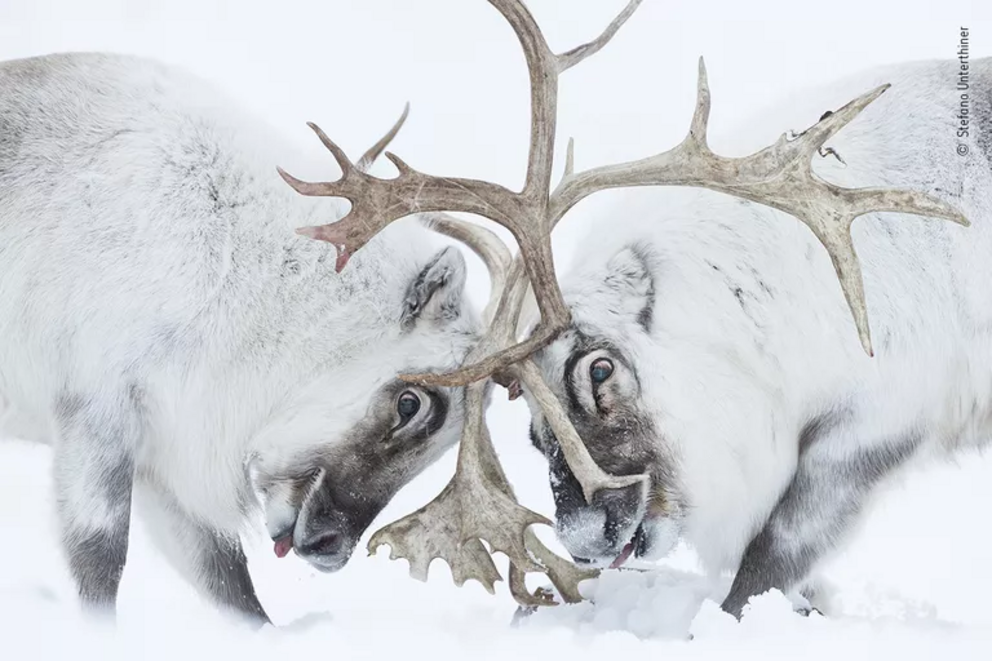Winning wildlife photos show nature at its most awesome
There are battling reindeer, polar bears playing, and several spiders.
There are polar bears playing, courting salamanders, melting sea ice, and one very venomous spider lurking under the bed. These are some of this year's winning images in the annual Wildlife Photographer of the Year competition.
Chosen from more than 50,000 entries from 95 countries, the winners highlight breathtaking moments in nature and wildlife.
The battling reindeer photo above was the winner in the Behaviour: Mammals category. Called "Head to head,” it was taken by Stefano Unterthiner of Italy who captured two Svalbard reindeer fight for control of a harem.
The museum directors describe the photo:
Stefano followed these reindeer during the rutting season. Watching the fight, he felt immersed in ‘the smell, the noise, the fatigue and the pain’. The reindeer clashed antlers until the dominant male (left) chased its rival away, securing the opportunity to breed.
Reindeer are widespread around the Arctic, but this subspecies occurs only in Svalbard. Populations are affected by climate change, where increased rainfall can freeze on the ground, preventing access to plants that would otherwise sit under soft snow.
Wildlife Photographer of the Year is developed and produced by the Natural History Museum, London. Here's a look at some of the other winners.
Grand Title Winner: Wildlife Photographer of the Year
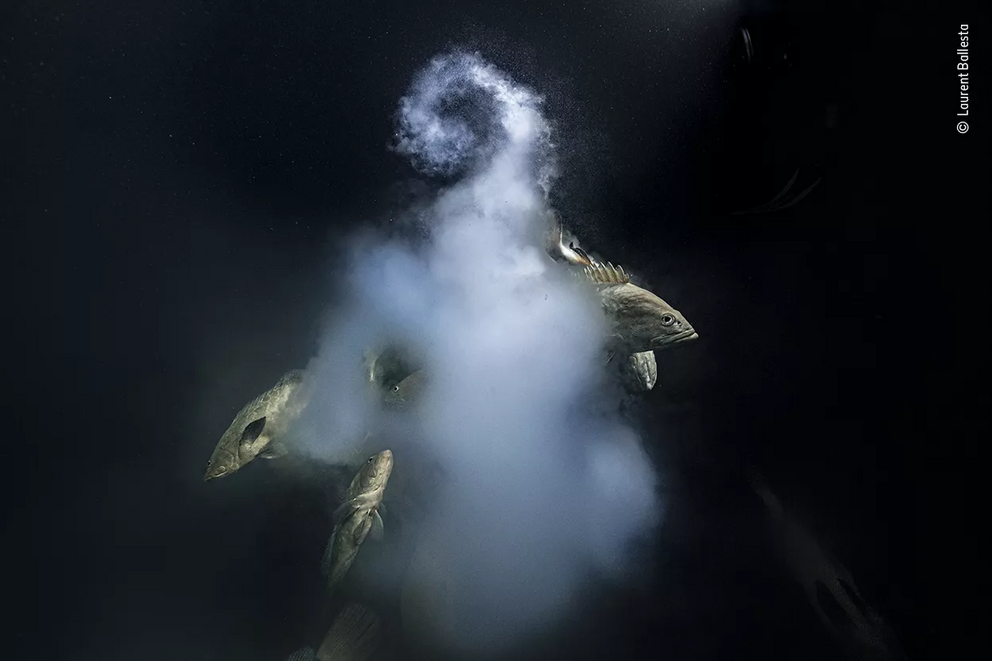
“Creation” by Laurent Ballesta, France
Underwater photographer and biologist Laurent Ballesta earned top honors as the 2021 Wildlife Photographer of the Year for his image, "Creation." It features three camouflage groupers in a cloud of eggs and sperm. Laurent and his team returned to the same lagoon in Fakarava, French Polynesia, every year, for five years, to watch the annual spawning. It only takes place around the July full moon when as many as 20,000 fish gather.
They were joined by hundreds of grey reef sharks who were hunting the fish. Although threatened by overfishing, here the fish are protected in a biosphere reserve.
"The image works on so many levels," says Rosamund ‘Roz’ Kidman Cox, chair of the judging panel. "It is surprising, energetic, and intriguing and has an otherworldly beauty. It also captures a magical moment – a truly explosive creation of life – leaving the tail-end of the exodus of eggs hanging for a moment like a symbolic question mark."
Young Wildlife Photographer of the Year

“Dome home” by Vidyun R Hebbar, India
Ten-year-old Vidyun R. Hebbar of India won the Young Wildlife Photographer of the Year 2021 for his image "Dome home." It features a tent spider against a colorful backdrop of a passing rickshaw.
The competition organizers describe the photo:
Exploring his local theme park, Vidyun found an occupied spider’s web in a gap in a wall. A passing tuk-tuk (motorised rickshaw) provided a backdrop of rainbow colours to set off the spider’s silk creation. Tent spiders are tiny – this one had legs spanning less than 15 millimetres. They weave non-sticky, square-meshed domes, surrounded by tangled networks of threads that make it difficult for prey to escape. Instead of spinning new webs every day, the spiders repair existing ones.
Vidyun was first featured in the competition when he was 8 years old. He said he likes to photograph the often-overlooked creatures that live in the streets and parks near his home in Bengaluru, India.
"The jury loved this photo from the beginning of the judging process," said jury member Natalie Cooper, a researcher with the Natural History Museum. "It is a great reminder to look more closely at the small animals we live with every day, and to take your camera with you everywhere. You never know where that award winning image is going to come from."
Winner, Animals in their Environment
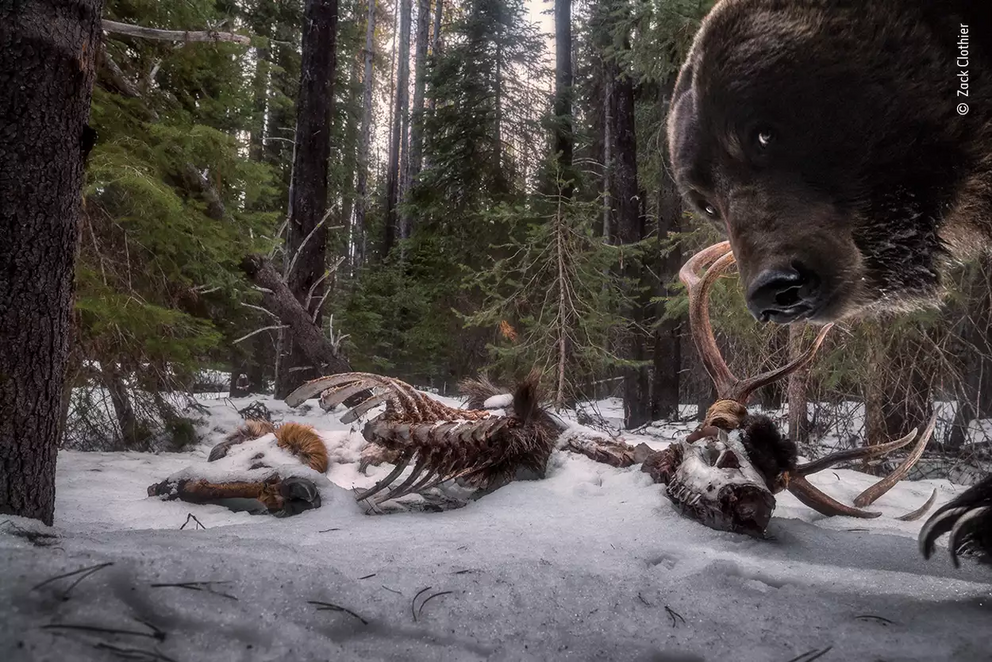
“Grizzly leftovers” by Zack Clothier, U.S.
Photographer Zack Clothier found that a grizzly bear was interested in his camera trap.
Zack decided these bull elk remains were an ideal spot to set a camera trap. Returning to the scene was challenging. Zack bridged gushing meltwater with fallen trees, only to find his setup trashed. This was the last frame captured on the camera.
Winner, Behaviour: Invertebrates
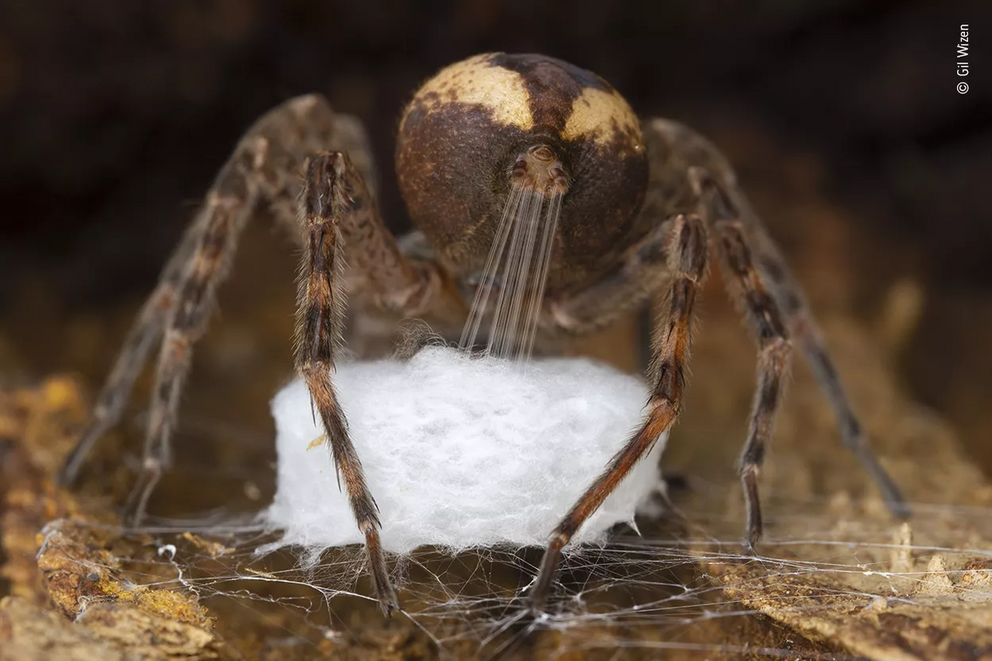
“Spinning the cradle” by Gil Wizen, Israel/Canada
Gil Wizen photographed a fishing spider sending silk from its spinnerets to weave into its egg sac.
Gil discovered this spider under loose bark. Any disturbance might have caused the spider to abandon its project, so he took great care. ‘The action of the spinnerets reminded me of the movement of human fingers when weaving,’ Gil says.
Winner, Behaviour: Birds
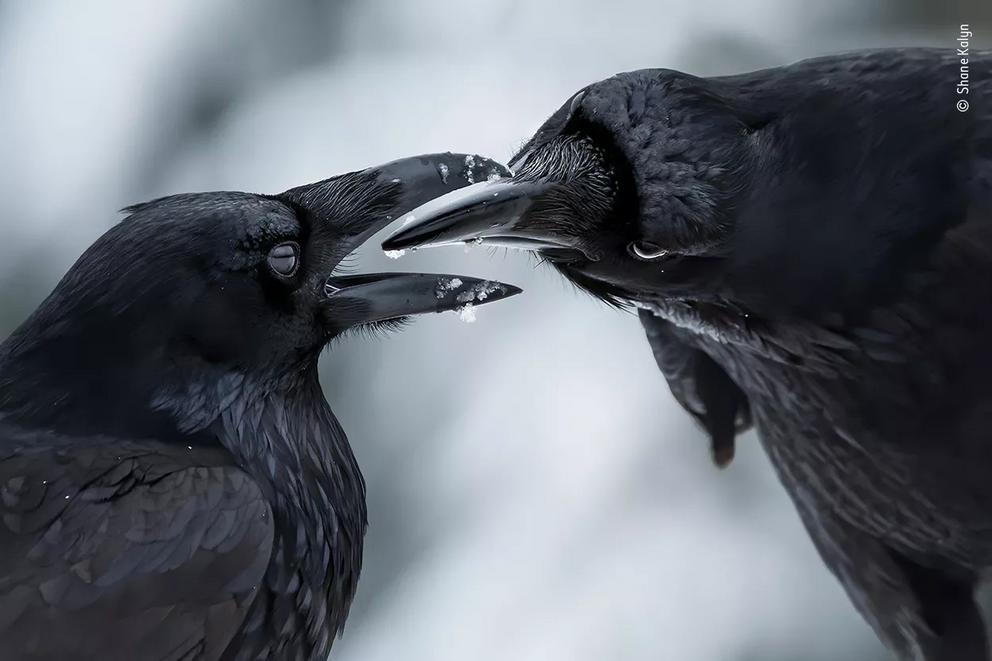
“The intimate touch” by Shane Kalyn, Canada
Shane Kalyn watched a courtship display between two ravens.
It was midwinter, the start of the ravens’ breeding season. Shane lay on the frozen ground using the muted light to capture the detail of the ravens’ iridescent plumage against the contrasting snow to reveal this intimate moment when their thick black bills came together.
Ravens probably mate for life. This couple exchanged gifts – moss, twigs and small stones – and preened and serenaded each other with soft warbling sounds to strengthen their relationship or ‘pair bond.’
Winner, Behaviour: Amphibians and Reptiles
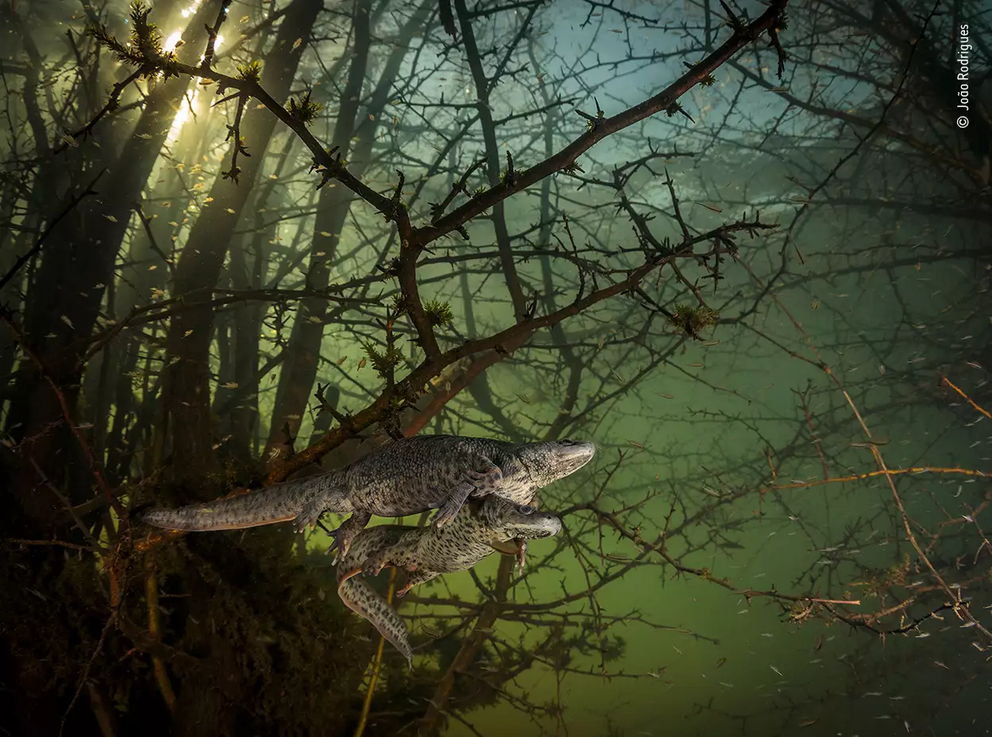
“Where the giant newts breed” by João Rodrigues, Portugal
João Rodrigues also saw animals courting. He witnessed sharp-ribbed salamanders in a flooded forest.
It was João’s first chance in five years to dive in this lake as it only emerges in winters of exceptionally heavy rainfall, when underground rivers overflow. He had a split second to adjust his camera settings before the newts swam away.
Winner, Oceans: The Bigger Picture

“Nursery meltdown” by Jennifer Hayes, U.S.
Jennifer Hayes photographed harp seals and seal pups and the blood that remains from birthing against melting sea ice.
Following a storm, it took hours of searching by helicopter to find this fractured sea ice used as a birthing platform by harp seals. ‘It was a pulse of life that took your breath away,’ says Jennifer.
Every autumn, harp seals migrate south from the Arctic to their breeding grounds, delaying births until the sea ice forms. Seals depend on the ice, which means that future population numbers are likely to be affected by climate change.
Winner, Plants and Fungi
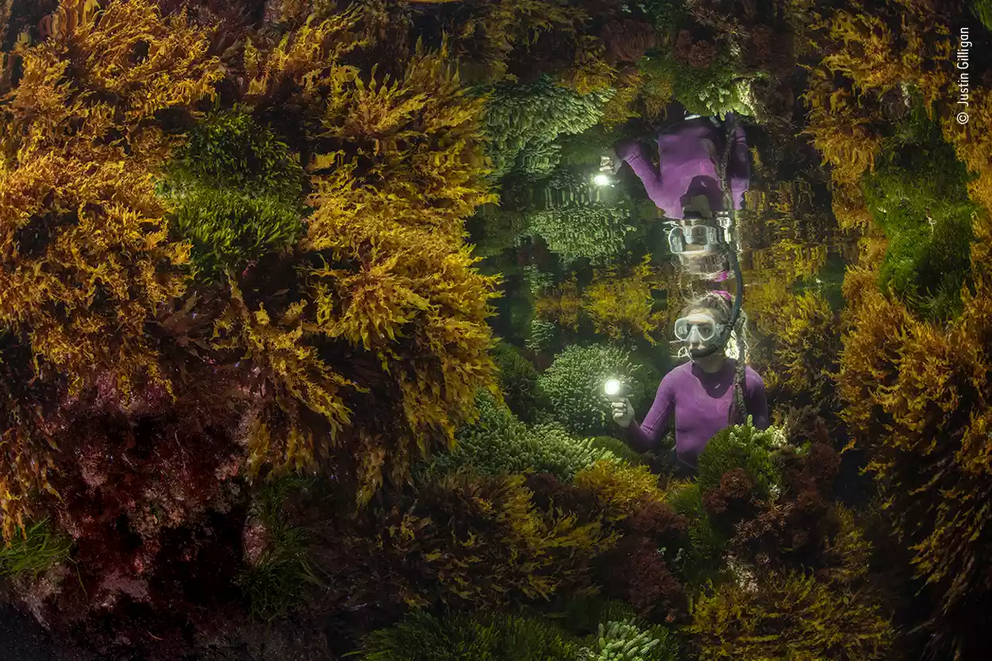
“Rich reflections” by Justin Gilligan, Australia
Justin Gilligan photographs a marine ranger and a reflection in the seaweed.
At the world’s southernmost tropical reef, Justin wanted to show how careful human management helps preserve this vibrant seaweed jungle. With only a 40-minute window where tide conditions were right, it took three days of trial and error before Justin got his image.
Winner, Urban Wildlife

“The spider room” by Gil Wizen, Israel/Canada
Gil Wizen finds a venomous Brazilian wandering spider hiding under his bed.
After noticing tiny spiders all over his bedroom, Gil looked under his bed. There, guarding its brood, was one of the world’s most venomous spiders. Before safely relocating it outdoors, he photographed the human-hand-sized Brazilian wandering spider using forced perspective to make it appear even larger.
Brazilian wandering spiders roam forest floors at night in search of prey such as frogs and cockroaches. Their toxic venom can be deadly to mammals including humans, but it also has medicinal uses.
Winner, Wetlands - The Bigger Picture
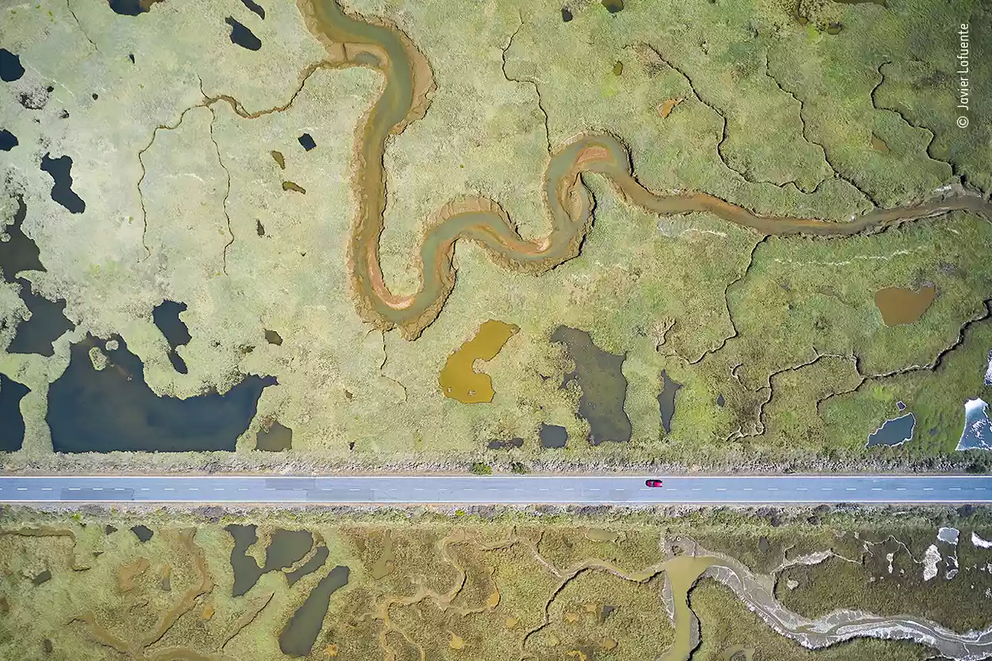
“Road to ruin” by Javier Lafuente, Spain
Javier Lafuente shows the stark, straight line of a road slicing through the curves of the wetland landscape.
By manoeuvring his drone and inclining the camera, Javier dealt with the challenges of sunlight reflected by the water and ever-changing light conditions. He captured the pools as flat colours, varying according to the vegetation and mineral content.
Dividing the wetland in two, this road was constructed in the 1980s to provide access to a beach. The tidal wetland is home to more than a hundred species of birds, with ospreys and bee-eaters among many migratory visitors.
Winner, Photojournalism
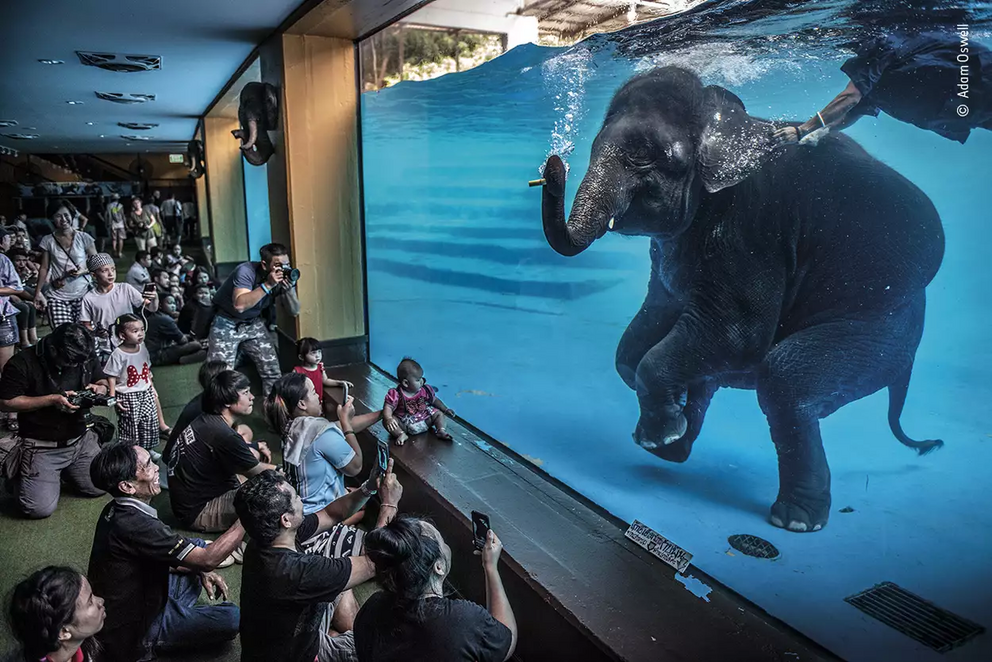
“Elephant in the room” by Adam Oswell, Australia
Adam Oswell draws attention to zoo visitors watching a young elephant perform under water.
Although this performance was promoted as educational and as exercise for the elephants, Adam was disturbed by this scene. Organisations concerned with the welfare of captive elephants view performances like these as exploitative because they encourage unnatural behaviour.
Elephant tourism has increased across Asia. In Thailand there are now more elephants in captivity than in the wild. The Covid-19 pandemic caused international tourism to collapse, leading to elephant sanctuaries becoming overwhelmed with animals that can no longer be looked after by their owners.
Winner, Photojournalist Story Award
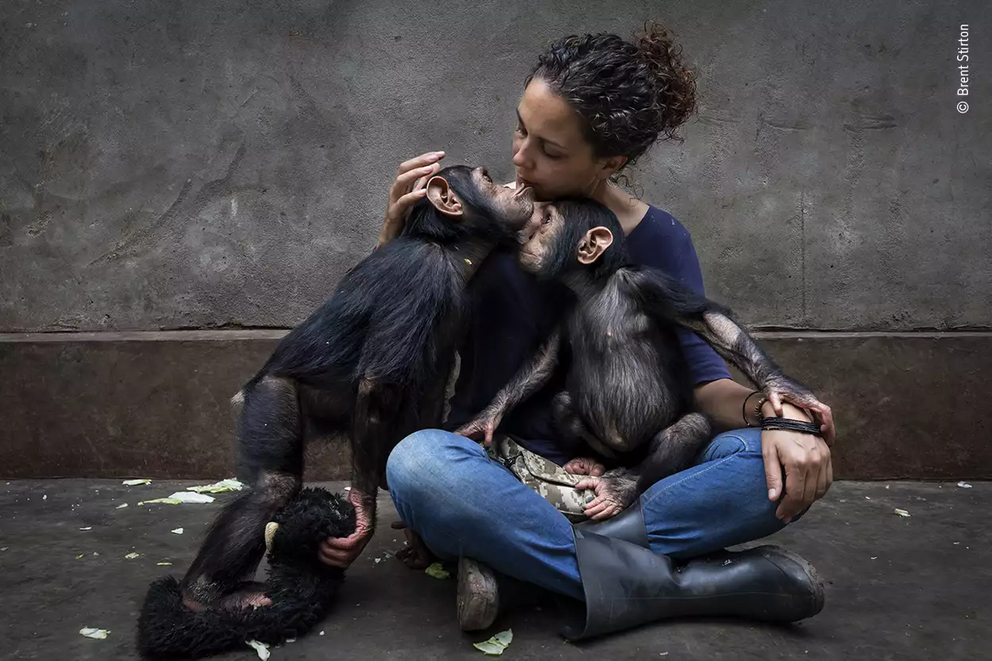
“The healing touch,” from “Community care” by Brent Stirton, South Africa
Caption:
Brent Stirton (South Africa) profiles a rehabilitation centre caring for chimpanzees orphaned by the bushmeat trade.
The director of the centre sits with a newly rescued chimp as she slowly introduces it to the others. Young chimps are given one-to-one care to ease their psychological and physical trauma. These chimps are lucky. Less than one in ten are rescued after having seen the adults in their group killed for meat. Most have experienced starvation and suffering.
Portfolio Story:
Many people around the globe rely on meat from wild animals – bush meat – for protein, as well as a source of income. Hunting endangered species such as chimpanzees is illegal but takes place all too frequently. Brent’s photographs document the work of the Lwiro Primate Rehabilitation Center, which rescues and rehabilitates primates orphaned by poaching. Many staff here are survivors of military conflict in the Democratic Republic of the Congo. Working at the centre helps with their own recovery.
Winner, Rising Star Portfolio Award
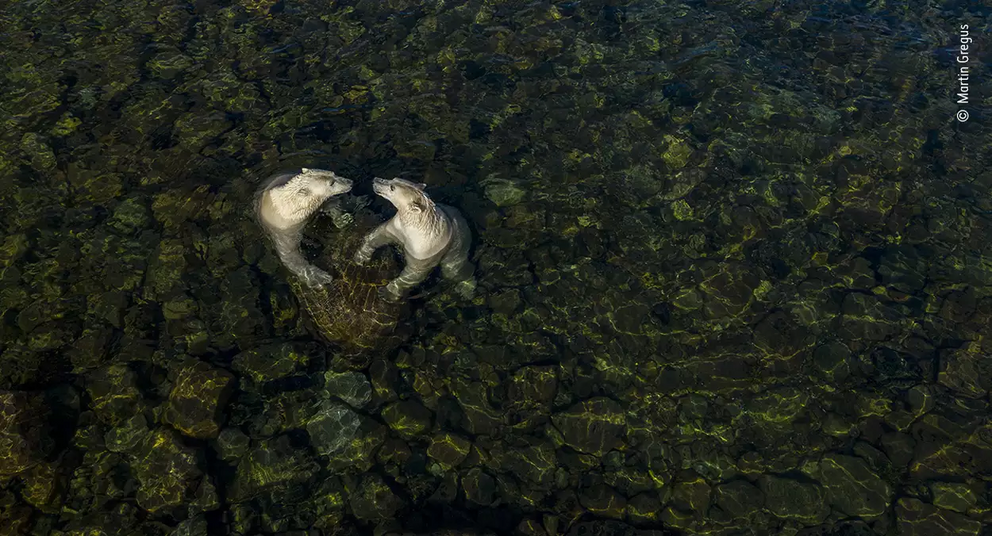
“Cool time,” from “Land time for sea bears” by Martin Gregus, Canada / Slovakia
Caption:
Martin Gregus shows polar bears in a different light as they come ashore in summer.
On a hot summer’s day, two female polar bears took to the shallow intertidal waters to cool off and play. Martin used a drone to capture this moment. For him, the heart shape symbolises the apparent sibling affection between them and ‘the love we as people owe to the natural world’.
Portfolio Story:
Martin spent three weeks on his boat using various techniques to photograph polar bears around Hudson Bay. Polar bears are mostly solitary and, while living on sea ice, can be dispersed over vast areas. Coming ashore in summer, they live mainly off their fat reserves and, with less pressure to find food, become much more sociable. While not wanting to detract from their plight in the face of climate change, Martin wanted to show polar bears in a different light.
Winner, Portfolio Award

“Face-off,” from “Cichlids of Planet Tanganyika” by Angel Fitor, Spain
Caption:
Angel Fitor provides an intimate look into the lives of cichlid fishes in Lake Tanganyika.
Two male cichlid fish fight jaw to jaw over a snail shell. Inside the half-buried shell is a female ready to lay eggs. For three weeks Angel monitored the lake bed looking for such disputes. The biting and pushing lasts until the weaker fish gives way. This struggle was over in seconds but lasted just long enough for Angel to get his winning shot.
Portfolio Story:
Lake Tanganyika, the oldest of the East African Great Lakes, is home to more than 240 species of cichlid fishes. Each has a unique body shape, size and behaviour to fill every kind of ecological niche. But despite teeming with life, this incredible ecosystem is under threat. Angel has worked on cichlids for two decades, braving difficult diving conditions to photograph their behaviour. Recently, chemical runoff from agriculture, sewage and over-exploitation by the unregulated ornamental fish trade have driven some cichlid populations towards extinction.

